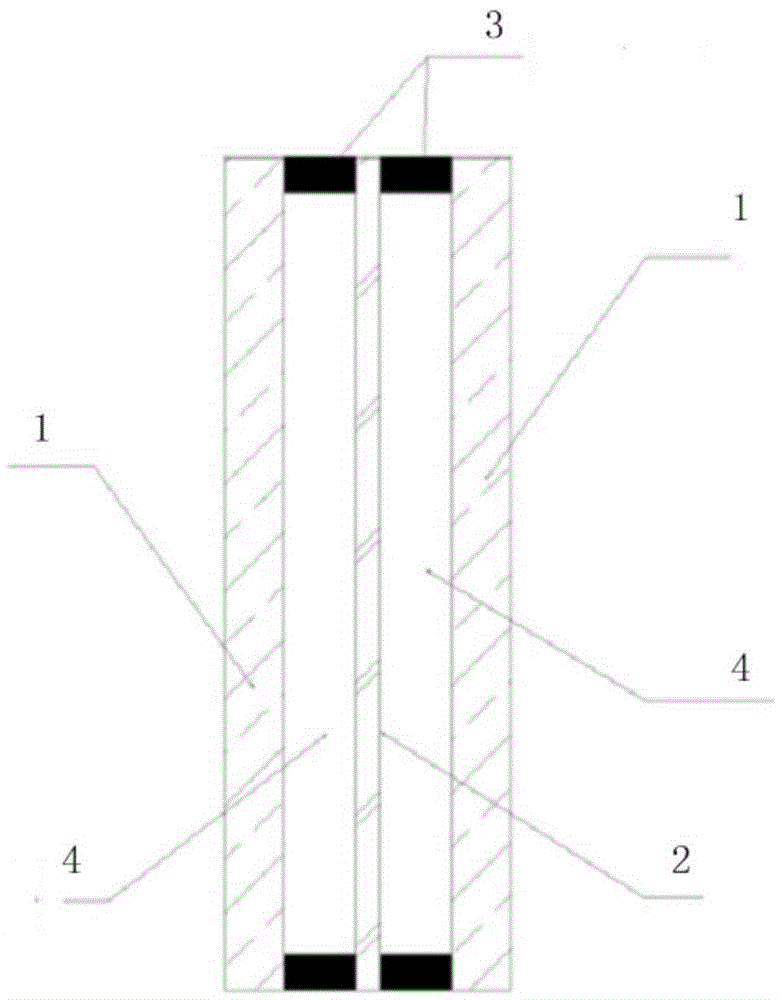Hollow two-cavity or multi-cavity nanometer composite energy-saving glass and preparing method thereof
A nano-composite, energy-saving glass technology, applied in the field of glass windows, can solve the problems of increased difficulty in construction, small radiation barrier, and increased self-weight of windows.
- Summary
- Abstract
- Description
- Claims
- Application Information
AI Technical Summary
Problems solved by technology
Method used
Image
Examples
Embodiment 1
[0050] 1. Preparation of nano-transparent heat-insulating and energy-saving coatings:
[0051] Adopting polyvinyl butyral PVB resin to be dissolved in ethanol to make a liquid resin with a solid content of 20wt%;
[0052]The tungsten oxide nanomaterial doped with lithium and potassium is ground and homogenized at high speed, and dispersed in ethanol under the action of a silane coupling agent to make a uniform 15wt% pre-dispersion;
[0053] Evenly disperse the pre-dispersion in proportion to 30wt% in the liquid resin, disperse at high speed for 1 hour, and make a transparent heat-insulating and energy-saving coating;
[0054] The above steps are carried out in a workshop with a cleanliness level of 10,000, the ambient humidity is controlled at 30-60%, and the ambient temperature is 25-30°C.
[0055] 2. Production of transparent nanocomposite sheet:
[0056] Material selection: select optical grade 2mm PET sheet;
[0057] Coating: Use coating equipment to coat PET sheets wit...
Embodiment 2
[0062] 1. Preparation of nano-transparent heat-insulating and energy-saving coatings:
[0063] Use PET resin with good transparency and good weather resistance to dissolve in methyl ester to make a liquid resin with a solid content of 40wt%;
[0064] Disperse tin-doped indium oxide nanomaterials in a solvent after high-speed grinding and homogenization to make a uniform 40wt% pre-dispersion;
[0065] Evenly disperse the pre-dispersion in proportion to 30wt% in the liquid resin, and disperse at high speed for 1 hour to make a transparent heat-insulating and energy-saving coating;
[0066] The above steps are carried out in a workshop with a cleanliness of 10,000 grades, the ambient humidity is controlled at 30-60%, and the ambient temperature is 25-30°C.
[0067] 2. Production of transparent nanocomposite sheet:
[0068] Material selection: select optical grade 0.1mm acrylic sheet;
[0069] Coating: Use coating equipment to coat the acrylic sheet with a transparent heat-insu...
Embodiment 3
[0074] 1. Preparation of nano-transparent heat-insulating and energy-saving coatings:
[0075] Adopt PC resin with good transparency and good weather resistance to be dissolved in toluene to make a liquid resin with a solid content of 25wt%;
[0076] The antimony-doped tin oxide nanomaterial is ground at high speed, homogenized, and dispersed in toluene under the action of a cellulose dispersant to prepare a uniform 30wt% pre-dispersion;
[0077] Disperse the pre-dispersion 20wt% evenly in the liquid resin, add an appropriate amount of polyurethane leveling agent, disperse at high speed for 3 hours, and make a transparent heat-insulating and energy-saving coating;
[0078] The above steps are carried out in a workshop with a cleanliness of 10,000 grades, the ambient humidity is controlled at 30-60%, and the ambient temperature is 25-30°C.
[0079] 2. Production of transparent nanocomposite sheet:
[0080] Material selection: select optical grade 1mmPC substrate sheet;
[00...
PUM
 Login to View More
Login to View More Abstract
Description
Claims
Application Information
 Login to View More
Login to View More - R&D
- Intellectual Property
- Life Sciences
- Materials
- Tech Scout
- Unparalleled Data Quality
- Higher Quality Content
- 60% Fewer Hallucinations
Browse by: Latest US Patents, China's latest patents, Technical Efficacy Thesaurus, Application Domain, Technology Topic, Popular Technical Reports.
© 2025 PatSnap. All rights reserved.Legal|Privacy policy|Modern Slavery Act Transparency Statement|Sitemap|About US| Contact US: help@patsnap.com

